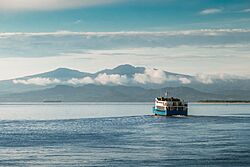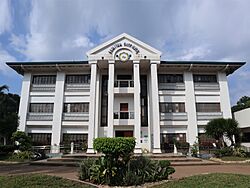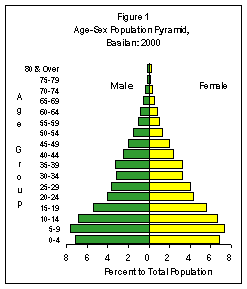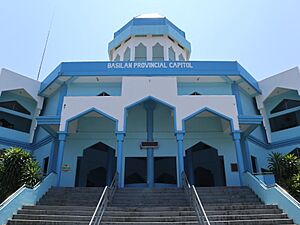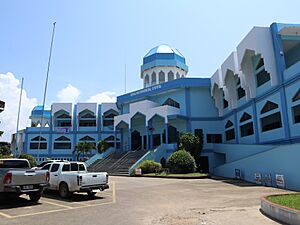Basilan facts for kids
Quick facts for kids
Basilan
|
|||
|---|---|---|---|
|
(from top: left to right) Basilan Peak, Forest Park in Isabela City, Lamitan City Hall and Basilan satellite image in 2016
|
|||
|
|||
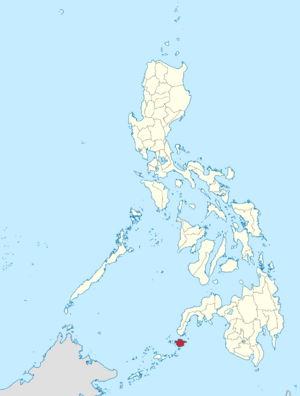
Location in the Philippines
|
|||
|
OpenStreetMap
|
|||
| Country | |||
| Region | Zamboanga Peninsula (Isabela City) |
||
| Chartered City | July 1, 1948 | ||
| Converted into a province | December 27, 1973 | ||
| Capital | Lamitan | ||
| Largest settlement | Isabela | ||
| Government | |||
| • Type | Sangguniang Panlalawigan | ||
| Area | |||
| • Total | 1,327.23 km2 (512.45 sq mi) | ||
| Area rank | 72nd out of 81 | ||
| Highest elevation
(Basilan Peak)
|
998 m (3,274 ft) | ||
| Population
(2020 census)
|
|||
| • Total | 556,586 | ||
| • Rank | 56th out of 81 | ||
| • Density | 419.3591/km2 (1,086.135/sq mi) | ||
| Demonyms |
|
||
| Divisions | |||
| • Independent cities | 0 | ||
| • Component cities |
2
Isabela
Lamitan |
||
| • Municipalities |
11
Akbar
Al-Barka Hadji Mohammad Ajul Hadji Muhtamad Lantawan Maluso Sumisip Tabuan-Lasa Tipo-Tipo, Basilan Tuburan Ungkaya Pukan |
||
| • Districts | Legislative district of Basilan | ||
| Time zone | UTC+8 (PST) | ||
| IDD : area code | +63 (0)62 | ||
| ISO 3166 code | PH-BAS | ||
| Languages | |||
| Income classification | 3rd class | ||
| Website | www |
||
Basilan, officially the Province of Basilan, is an island province in the Philippines. It is mainly part of the Bangsamoro Autonomous Region. Basilan Island is the largest and most northern of the main islands in the Sulu Archipelago. It is located just off the southern coast of the Zamboanga Peninsula.
Isabela is the most populated city and used to be the capital. It is a component city under Basilan's provincial government. However, it is managed as part of the Zamboanga Peninsula Region and is counted separately. The provincial capital is now Lamitan. Even so, some national government offices are still in Isabela.
Basilan is home to three main groups of people: the native Yakans, and the Tausugs and Chavacanos who arrived later. Most Yakans and Tausugs are Muslim, while Chavacanos are mainly Christian. There are also other smaller ethnic groups. While the official languages are Filipino and English, the main local language is Yakan, and Chavacano is often used for communication between different groups. Other languages include Tausug, Cebuano, and Sama.
Basilan is a 3rd-class province based on its income. However, it has one of the lowest rates of poverty in the Philippines. This means that the difference between rich and poor people in Basilan is one of the smallest in the country.
Contents
Understanding the Name of Basilan
Long ago, Antonio Pigafetta from the Magellan Expedition called Basilan "Taghima." This name appeared in many old European maps. The name "Basilan" was first recorded by a Jesuit historian, Fr. Colin.
Local Yakan people have old stories that mention other names for Basilan before history was written. These include "Uleyan" and "Matangal," which came from mountains used as landmarks by traders.
Other names given to the island were "Puh Gulangan" (island of forests) and "Umus Tambun" (fertile land). "Kumalarang" was another name, after a river on the island's western side.
The name "Basilan" likely came from misunderstandings between the local people and the Spanish. It might also come from the island's iron ore. Tausug warriors from Sulu came to Taguima to buy high-quality magnetic iron for their weapons. This trade led to the island being known as the source of basih-balan, which means "magnetic iron" in Tausug. Basih-lan can also mean "the iron trail" or "the iron way."
Old Spanish maps started using "I. Basilan" around 1749. By 1757, an official Spanish map showed "Basilan," and it has been called "Isla de Basilan" (Basilan Island) ever since.
Basilan's Past: A Brief History
Early Beginnings
Tens of thousands of years ago, Melanesians arrived in the Philippines, traveling to Mindanao. Later, thousands of years ago, Austronesians also arrived in the Philippines, reaching Mindanao.
Ancient Times
The Yakan people arrived in the Sulu Archipelago, including Basilan, around 300 to 200 BCE. Not much is known about them before the Spanish arrived. They are still the largest ethnic group on Basilan's main island. It is thought that the Yakan people had contact with the Kingdom of Champa in Vietnam, and some Yakans have ancestors from Champa settlers who later joined the Yakan community.
As the Tausug Sultanate of Sulu grew stronger, the Yakans moved further inland. Most coastal areas then became home to Tausugs and their related tribes, the Samals and Bajaus. The Yakan communities in Lamitan were an exception, as they remained quite successful.
Taguima and the Name Change
Old records from the Sulu Sultanate called the northernmost island of the Sulu Archipelago "Taguima." This name came from the Yakan people, who were called "Tagihamas" (people of the interior) by the Tausug and Samal people who settled along Basilan's coasts.
Later, the island was sometimes called "Bantilan," possibly referring to Maluso, which was a major Tausug base.
Ancient Chinese texts mention a "Kingdom of Kumalarang" during the Ming Dynasty. This kingdom is believed to have been on Basilan, named after a place for celebrations.
The remnants of the Ferdinand Magellan expedition saw and mentioned Basilan in 1521. Early maps of the Philippines, like one from 1548, showed an island called "Taguima." Over time, due to communication differences and map-making choices, these names changed to "Basilan."
The name "Basilan" might also come from its iron deposits. Tausug warriors bought high-quality iron from the island for their weapons. This trade led to the island being known as the source of basih-balan, meaning "magnetic iron." When Spanish officials saw these weapons, they asked where they came from. The warriors pointed to the island and said "ha basih-lan," meaning "to the iron way."
Spanish Rule
The Spanish began to colonize Basilan as early as 1636. The Sulu Sultanate officially gave Basilan to Spain in 1726. As the Spanish set up bases on the island's northwest coast, they brought Christian settlers from Zamboanga, Visayas, and Luzon. This caused the Yakans to move further inland. Jesuit missionaries introduced Catholicism to the area. Over the years, there were conflicts with the Sultanate, the Dutch East India Company, Moro Pirates, and the French.
American and Japanese Eras
After winning the 1898 Spanish–American War, the United States took control of the Philippines. Americans developed Basilan, clearing land for plantations, mainly for rubber and copra.
During World War II, Japan occupied the Philippines. After the war, in 1946, the Philippines became independent. Around 1970, heavy fighting started between the Philippine government and the Moro National Liberation Front, who wanted to form a new country.
Philippine Independence and Modern Times
In 1973, Basilan officially became a province, separated from Zamboanga del Sur.
In 2001, the province joined the Autonomous Region in Muslim Mindanao (ARMM). Isabela City, the former capital, chose not to join and remains part of the Zamboanga Peninsula Region.
Lamitan became a component city in 2007. Its city status was challenged twice but was finally confirmed by the Supreme Court in 2011.
Basilan's Geography
Basilan is located between 6°15' and 7°00' North latitude and 121°15' and 122°30' East longitude. The island is surrounded by the Basilan Strait to the north, the Sulu Sea to the northwest and west, the Moro Gulf to the northeast, and the Celebes Sea to the south, southeast, and east.
Basilan is the largest and northernmost island of the Sulu Archipelago, which includes about 400 islands. The Basilan Strait, about 17 nautical miles (31 km) wide at its narrowest, separates Basilan Island from Mindanao and Zamboanga City. The island's land is mostly simple, with gentle slopes near Isabela City and hills further inland. Urban areas are usually 2.5 meters above sea level, sloping up to 300 meters in the countryside. Forests are spread out across the island.
The province includes Basilan Island and nearby islands, like the Pilas Island group (now Hadji Muhtamad Municipality) and the Bubuan and Tapiantana Island group (now Tabuan-Lasa Municipality). These islands have a moderate risk of tsunamis. The province covers a land area of 1,327.23 square kilometers. Basilan Island itself is 1,265.5 square kilometers with a shoreline of 169.8 kilometers.
Basilan National Park is in the eastern part of the remaining public forest, between Isabela City and the municipalities of Lamitan, Tipo-Tipo, and Sumisip. The park is 971 meters above sea level, and its tallest peak, Puno Mahaji or Basilan Peak, stands out in the landscape.
Climate and Weather
| Climate data for Basilan, Philippines | |||||||||||||
|---|---|---|---|---|---|---|---|---|---|---|---|---|---|
| Month | Jan | Feb | Mar | Apr | May | Jun | Jul | Aug | Sep | Oct | Nov | Dec | Year |
| Record high °C (°F) | 39 (102) |
42 (108) |
37 (99) |
41 (106) |
37 (99) |
42 (108) |
40 (104) |
38 (100) |
41 (106) |
37 (99) |
37 (99) |
38 (100) |
42 (108) |
| Mean daily maximum °C (°F) | 28 (82) |
27 (81) |
27 (81) |
28 (82) |
28 (82) |
28 (82) |
28 (82) |
27 (81) |
28 (82) |
27 (81) |
27 (81) |
27 (81) |
27 (81) |
| Mean daily minimum °C (°F) | 24 (75) |
23 (73) |
23 (73) |
24 (75) |
24 (75) |
25 (77) |
24 (75) |
24 (75) |
24 (75) |
24 (75) |
24 (75) |
23 (73) |
23 (73) |
| Record low °C (°F) | 17 (63) |
17 (63) |
20 (68) |
13 (55) |
21 (70) |
20 (68) |
17 (63) |
21 (70) |
15 (59) |
13 (55) |
21 (70) |
20 (68) |
13 (55) |
| Average precipitation cm (inches) | 4 (1.6) |
5 (2.0) |
4 (1.6) |
5 (2.0) |
9 (3.5) |
12 (4.7) |
13 (5.1) |
12 (4.7) |
13 (5.1) |
16 (6.3) |
11 (4.3) |
8 (3.1) |
119 (47) |
| Source: Weatherbase | |||||||||||||
Basilan's climate is similar to other areas in the Zamboanga Peninsula. The average yearly rainfall is 1,100 mm, and the average temperature is 26.6°C. Rain comes from the southwest monsoon and the island's location in the Intertropical Convergence Zone. The climate is a tropical wet and dry climate.
Basilan is outside the typhoon belt. Winds usually come from the southwest at 4 kilometers per hour.
The months from March to May are hot and dry, with temperatures around 22°C. June to October is the rainy season. November to February is cooler, with temperatures from 22°C to 28°C. The average humidity all year is 77%.
Cities and Towns of Basilan
Basilan is divided into 11 municipalities and two cities. There are 255 barangays (villages).
Basilan used to be part of Western Mindanao (now Zamboanga Peninsula). However, in 2001 and 2019, most residents chose to join the ARMM and then Bangsamoro. Isabela City, however, voted against joining and remains part of the Zamboanga Peninsula.
Cities
- Isabela is on the northern shore of Basilan Island, facing Zamboanga City. It is a component city of the province. It was the capital from 1975 to 2017. It still hosts the Basilan Provincial Capitol and many government offices. Its original name was Pasangen. In 1848, it was renamed Isabela de Basilan after a Spanish fort. It became Isabela Municipality in 1973 and the City of Isabela in 2001. Isabela votes for provincial officials and shares tax revenues with the province. However, for regional and statistical purposes, it is grouped under Zamboanga Peninsula.
- Lamitan is the capital and a component city of Basilan, located on the island's northeastern coast. Most Bangsamoro regional offices for the province are in Lamitan. It became the new capital in 2017. The name comes from Sultan Kudarat's capital town, Ramitan. The Iranun Sultan built a fort here for raids on Spanish Zamboanga. Locals called it "Ramitan," which later became "Lamitan." In 2007, it became a city, lost the status in 2008, but regained it in 2011 after a court ruling.
Municipalities
The other five original municipalities are:
- Maluso is on the island's southwest. Its busiest trading port is at Port Holland. The name comes from Spanish "mal uso" (bad manners), referring to the manners of the natives when the Spanish arrived.
- Lantawan is in the island's westernmost area. It is mainly an agricultural area for copra and rubber. Its name comes from "lantaw" (look), as its hills served as "lookouts" for natives watching ships.
- Sumisip is the largest municipality by land area. It used to have the biggest rubber plantation in the Philippines.
- Tuburan is on a peninsula in the far eastern part of the island. It is one of the least developed municipalities. Its name comes from "tubod" (water spring), as there is a spring in the area.
- Tipo-Tipo is on the island's southeast coast. It is named after "Tipun-tipunan" (gathering place), where natives would meet to trade goods.
Six newer municipalities were created by the ARMM regional legislature:
- Akbar (created in 2005 from Tuburan), named after a political leader.
- Al-Barka (ratified in 2006).
- Hadji Mohammad Ajul (ratified in 2006, from Tuburan), named after Tuburan's first mayor.
- Hadji Muhtamad (ratified in 2007), named after the father of a former governor and separated from Lantawan.
- Tabuan-Lasa (ratified in 2008), separated from Sumisip and named after its main islands.
- Ungkaya Pukan (ratified in 2006), named after an ancestor of a local family.
Some of these new municipalities may not meet the requirements for creating a municipality under Philippine law. As a result, some have not received national funding.
|
|||||||||||||||||||||||||||||||||||||||||||||||||||||||||||||||||||||||||||||||||||||||||||||||||||||||||||||||||||||||||||||||||||||||||||||||||||||||||||||||||||||||||||||||||||||||||||||||||||||||||||||
People and Culture of Basilan
Basilan's Diverse Cultures
Basilan's culture is shaped by its three main groups: the native Yakan, Tausug, and Chavacano peoples. Most Yakans and Tausugs are Muslim, while Chavacanos are mainly Catholic.
Among the Tausugs and Samals, "mag-tausug na kaw" means "become a Muslim." This is because Tausugs are seen as the "original Muslims" of the area. While most Yakans are Muslim, some follow traditional local beliefs. A few have also become Christians or have no religious beliefs. Along with most Chavacanos, Cebuanos and Ilonggos are also Catholics.
Culturally, Yakans and Tausugs are distinct groups. Yakans are the indigenous people of Basilan. Tausugs, Samals, and Bajaus are considered the "original Muslims." Chavacanos, Cebuanos, and Ilonggos are the "Christians." Other groups like Ilocanos, Warays, and Maranaos are more recent migrants.
This mix of people, brought together by Spanish settlements and plantations, gives Basilan a unique culture. It is the only mostly Muslim province governed by its native people, where Chavacano is the most common language.
Tausugs and Samals, who often fish, live along the coast in houses built on stilts. They control most of the island's sea resources.
Yakans live inland in separate, raised houses made of light materials. They hold many local government positions and work in government jobs. Christians mostly live in the plains, cities, and plantations. They are often professionals, business owners, and farmers. They own most of the farmland and businesses.
Tausug and Samal festivals are often about the sea, celebrating its bounty. Catholic fiestas are usually about good harvests or saintly miracles. Yakan festivals are based on older, pre-Islamic rituals, including warrior dances and harvest ceremonies.
Basilan's location at the center of conflicts between Tausugs and the Spanish divided it into three cultural areas. The northern and northwestern coasts, facing Zamboanga City, are mostly Christian. The southern and southwestern coastal areas have a strong Tausug culture. The eastern and interior parts of Basilan are home to the indigenous Yakan people.
Population and Demographics
By the time the Commonwealth era began in the Philippines, most people in Basilan were Christian migrants. These were mostly plantation workers from Mindanao and the Visayas, along with Tausug traders, and Samal and Bajau fishers. Only about 5,000 Yakans were counted then, as most preferred not to interact with their lowland neighbors.
According to the 2010 Census, out of 391,179 people:
- Indigenous Yakan: 161,791 (41.36%)
- Christians (Chavacano, Visayans, Ilocano, etc.): 128,698 (32.9%)
- Other Muslim Tribes (Tausug, Samal, Bajao, Iranon): 100,690 (25.74%)
Basilan's median age was 19 years in 2010, which is younger than the 25 years recorded in 1995. The number of males and females is almost equal.
The working-age population (15 to 64 years old) makes up 55.2% of the total. About 42.3% are young dependents (0 to 14 years old), and less than 3% are older dependents (64 years and older).
In 2000, 47.76% of people aged 10 and over were married. Single people made up 43.80%.
Most housing units in Basilan in 2000 were single houses (94.3%). About 75.9% of these homes needed no or only minor repairs.
In 2000, the use of galvanized iron/aluminum for roofs increased to 42.5%. The use of cogon/nipa/anahaw for roofs decreased to 50.3%. For outer walls, wood use increased to 52.4%.
Out of Basilan's estimated 60,582 families, 19,740 lived in urban areas and 40,842 in rural areas. The average monthly income needed to meet basic needs was Php9,271.00. About 26.20% of the total population lived below the poverty line.
Population Changes
Basilan's population grew quickly between 2000 and 2007, increasing by 163,675 people. However, between 2007 and 2010, the population decreased by 105,324 people. This change was due to stricter ways of counting the population.
Only two areas saw population increases from 2007 to 2010:
- Isabela City grew from 87,985 to 97,857.
- Tabuan Lasa grew from 13,384 to 18,635.
The other areas recorded significant population declines during this period.
Religion in Basilan
Islam
Most of Basilan's population (65%) is Muslim. The rest are mostly Christian (mainly Roman Catholic), making up 33%. Most Muslims in Basilan (41%) follow Sunni Islam of the Shafi'i tradition. This was taught by missionaries from the 14th century onwards. Many Yakans also mix Islam with traditional folk customs. The Bajao people in Basilan's islands also have their own folk Islamic traditions.
Most Muslims live on the island's southern slopes. Christians mainly live in the urban centers of Isabela and Lamitan on the northern coast, where they are the majority. Christian communities are also found in former plantations.
Newer Islamic groups, like the Tableegh, have been active in promoting a "purer" Islamic way of life. A small number of people have converted to Shiite Islam.
Catholicism
The first Catholic mission in Basilan was established in 1637. The Order of Augustinian Recollects took over in 1850. The Jesuits returned for a time, but the Recollects administered the parish until 1920. From 1930 to 1950, the Jesuits were back. Finally, the Claretian Fathers took over from 1951 to 1974.
The Isabela Parish church burned down in 1962 and was rebuilt in 1964. The cathedral was dedicated to Santa Isabel in 1970. It was damaged by a bomb blast in 2010.
The Prelature of Isabela de Basilan was created in 1963. It covers all of Basilan Province, including Isabela. Its patron saint is Santa Isabel de Portugal.
Other Religions
Other Christian groups include Evangelicals, Jesus Miracle Crusade, Episcopalian, and Iglesia ni Cristo (INC). There are also Mormons, Seventh-day Adventists, and Jehovah's Witnesses. Only the newest Chinese immigrants follow Buddhism or Taoism. Most older Chinese families have adopted Christianity or Islam while keeping some Chinese beliefs.
Languages Spoken in Basilan
Basilan is home to several groups, each with their own language. The main languages are Chavacano, Tausug, Yakan, and Cebuano (Bisaya). Chavacano is the main language for Christians and is widely used for communication across the island. About 80% of residents can speak and understand it. Basilan has the largest number of Chavacano speakers outside of Zamboanga City.
Tausug is also widely spoken, especially among Muslims, by about 70% of Basilan's population. Cebuano is a popular third language for both Christians and Muslims. This is because many Cebuanos settled in Mindanao, and Tausug is a Visayan language like Cebuano. About 70% of Basilan's residents speak and understand Cebuano.
Yakan is the native language of Basilan. It is mainly used by Yakans, but about 15%-20% of non-Yakan residents also speak or understand it. Fewer people speak or understand Samal/Banguingui and Iranon, which are mostly used by their own ethnic groups. Many locals and traders can speak Sabah Malay.
Tagalog and English are used for official government business. Hokkien Chinese is used by the Chinese community. Arabic is mostly used in Muslim prayers and songs, rarely in daily conversation.
Education in Basilan
Basilan's literacy rate has improved, but it is still lower than the national average. About 72.23% of people can read and write, compared to 92.6% nationwide.
The province has one state college and five private colleges. Basilan State College is in Isabela, with branches in Lamitan and Maluso. Private colleges include Computer Technologies Institute-Isabela (established 1997) and The Mariam School of Nursing in Lamitan (established 2004).
Basilan has three school divisions under the Department of Education: one for Basilan, one for Isabela, and one for Lamitan. Public and private high schools are found throughout the province. The main high school is Basilan National High School in Isabela, followed by Lamitan National High School. Claret High Schools and Madaris (Islamic schools) offer private education. Claret College of Isabela is the only Claretian school offering college education in the Philippines.
More than 42% of people aged five and older have completed elementary education. About 17.3% have completed high school, and 1.5% have completed post-secondary education. Less than 3% have college degrees.
Basilan's Economy
|
||||
Agriculture is the main way people earn a living in Basilan. The main products are coconut (mostly copra), rubber, coffee, black pepper, and African palm oil. Other crops include palay (rice), corn, cacao, and cassava.
The Sulu and Celebes Seas provide fish like tuna, mackerel, and sardines. These are often processed in factories in nearby cities. The island's waters also have grouper, squid, octopus, and marlin. Fishponds provide milkfish, prawn, and shrimp. Also, seaweed is grown along some coastal areas.
Basilan has potential for ocean thermal energy and ocean tidal energy. It also has mineral deposits like iron ore, gold, manganese, copper, and coal that are not yet fully developed.
About 862.249 square kilometers of land are available for use, and 406.526 square kilometers are forest lands. About 689.479 square kilometers are used for farming.
Local products include woven cloth and trinkets made by the Yakan tribe. Yakans use plant fibers like pineapple for their crafts. They traditionally used natural dyes from leaves and barks. However, they now also use chemical dyes. The museum in Lamitan shows colorful Yakan textiles and highlights of the Lami-lamihan festival.
Early Economy and Plantations
Basilan's economy has changed a lot over centuries. Before the Spanish arrived, the economy was based on basic farming. Ancient Chinese texts mention a "Kingdom of Kumalarang" that traded with Chinese merchants.
When the Spanish came, crops like rice and corn were introduced. Trade with Zamboanga grew as settlers' needs were met by shipments from Zamboanga.
When the United States took control, it brought big changes. Around 1914, Dr. James W. Strong started the Philippines' first commercial rubber plantation, the American Rubber Co. He also helped build roads in Basilan.
The plantation grew and was visited by important people like President Manuel L. Quezon. Later, large companies like B. F. Goodrich and Sime Darby Corp. invested in rubber plantations. Filipinos and Spanish-mestizo families also started their own plantations, like Basilan Estates, Inc., which grew coconuts. Logging companies also operated in Basilan's forests.
By the 1950s and 1960s, Basilan was a first-class city. It exported copra, coconut oil, rubber, and lumber. Many foreign plantation managers lived and married into the local population.
Economic Challenges
The Moro uprising in 1971 affected Basilan's economy. This, along with the declaration of martial law in 1972, created Basilan Province. Conflicts between different groups led to economic difficulties.
The Comprehensive Agrarian Reform Program (CARP) in 1988 also impacted Basilan's economy. This program distributed land, causing many large corporations to withdraw their investments. Farmers' cooperatives took over the plantations.
In the early 1990s, a group called Al-Harakatul Al-Islamiyah, known as Abu Sayyaf, formed. This group caused problems with kidnappings and other criminal acts, which hurt the economy.
Basilan joined the Autonomous Region in Muslim Mindanao (ARMM) in 2001. However, Isabela City chose not to join. Corruption and terrorist activities further weakened Basilan's economy.
After the 2001 hostage crisis, the presence of Philippine and U.S. militaries increased. This led to investments from the United States through USAID for projects like road improvements and port upgrades. These projects aimed to boost economic growth.
Return of Rubber and Other Products
By 2003, Basilan started large-scale replanting of rubber and cassava. As of 2006, about 15,503 hectares were planted with rubber. A group of farmer cooperatives formed to improve rubber quality and production.
Coconut production, though still the largest crop, decreased in 2003. This was due to the effects of CARP, weather patterns, and security issues. However, coconut plantations began to recover in 2006 due to rising copra prices.
Basilan's coastlines support fishers. Annual fish production is about 28,073 metric tons. Rice production is 2,945 metric tons, corn 1,333 metric tons, bananas 20,458 metric tons, and mangos 211 metric tons.
Banking and Infrastructure
Banks in Basilan have a total deposit base of over Php764,500,000. There are also many pawnshops. Government financial institutions like the Social Security System and the Government Service Insurance System also have offices.
The Basilan business sector is represented by the Philippine Chamber of Commerce & Industry, Inc.-Basilan Chamber (PCCI-Basilan).
Basilan's electricity comes from the Basilan Electric Cooperative, powered by diesel plants and mini-hydroelectric plants. However, many areas still lack electricity. Rates are among the highest in the country.
Basilan has three local water utilities. Only 17,693 households have full access to safe drinking water.
The island has a Provincial Telephone System with 600 landline connections. It is also served by major mobile networks like Globe Telecommunications and Smart Communications. There are also Wi-Fi internet providers and internet cafes.
National roads total 131.92 kilometers, and local roads total 795.8 kilometers. There are 13 municipal and local ports, three with roll-on/roll-off capability. There are also private airstrips. Major bridges include the Marcos Bridge and the Matarling Bridge.
There are 394 Barangay Health Workers and four private hospitals. There are also four government-run hospitals.
Fun Things to See and Do in Basilan
Architectural landmarks include the Santa Isabel Cathedral, the Calvario Peak, and the Kaum Purnah Mosque. Natural attractions include the lake in Panigayan fishing village, Sumagdang Beach, and the waterfalls of the Kumalarang River. You can also visit the cultures of the Badjao, Yakan, and Muslim communities.
Churches and Shrines
- Chapel of Peace, Calvario Peak, Isabela: This chapel is 400 meters above sea level and offers great views.
- Santa Isabel Cathedral, Isabela: An art deco cathedral with a mosaic altar, named after Isabela's patron saint.
- Monte Santo Shrine, atop Mt. Ubit in Lamitan: A place where Catholics go for pilgrimage, especially during Holy Week.
- Kaum Purnah Mosque, Isabela: An old and impressive mosque that welcomes visitors arriving by ferry.
Historical Places
- Datu Kalun Shrine, Lamitan: A park built to honor a famous Yakan leader.
- Museo ng Lamitan: This museum showcases the Lami-lamihan festival and provides information about Lamitan.
- Old Basilan Provincial Capitol: This was the site of Fort Isabela II. A new Capitol Building was built here after the old one was destroyed. It shows a mix of Muslim and Christian influences.
- Isabela City Plaza (formerly Plaza Misericordia) /Plaza Rizal: These twin plazas are still central to Basilan's social and political life.
Festivals and Celebrations
- Pakaradjaan Basilan: Celebrated annually from March 1 to 7 to mark the founding anniversary of Basilan Province.
- Lami-Lamihan Festival: The island's main festival, celebrated during the Feast of St. Peter on June 29 in Lamitan City. Yakans attend in traditional clothing, selling goods from their farms.
- Cocowayan' Festival: Isabela's annual celebration of its cityhood, ending with a Street Dancing parade on April 25.
- Fiesta Santa Isabel: Celebrated every July 8 by Isabela residents to honor their patron saint, Elizabeth of Portugal. It includes a procession, masses, and other activities.
- Semana Santa (Holy Week): Celebrated in March/April. A procession called Santo Entierro on Good Friday shows scenes from Christ's last hours.
- Flores de Mayo (May 1–31): A religious feast in Catholic churches honoring the Virgin Mary. Children offer flowers to her image.
- Fonda de Barangay or Fiestas del Barangay: Week-long celebrations in villages honoring their patron saints. They include masses, pageants, and merry-making.
- Budbud Festival: A village fiesta honoring Nuestra Senora dela Regla of Begang Barangay. It includes beauty pageants, street dancing, and eating "budbud" (rice cake).
- Pascua (Christmas): The December 25 celebration of Jesus Christ's birth. The city is decorated with lights and sounds.
- Isra Wal Miraj (May 9): An Islamic event celebrating the journey of Muhammad to Heaven.
- Eid al-Fitr/Hari Raya Puasa (movable): An Islamic event marking the end of the Muslim fasting season.
- Maulidin-Nabi (December 27): An Islamic celebration honoring the birthday of Muhammad.
- Chinese New Year (movable): Celebrated in February, known for noise-making and special foods.
Basilan's Government
Basilan's politics are influenced by its economy and diverse groups. Christian groups, though a minority, own much of the developed farmland. The Yakan tribe controls local governments outside Isabela and Lamitan. Tausugs, Samals, and Bajaus control most of the island's fishing. The small Chinese community handles most trading and commerce.
This mix of groups has shaped Basilan's politics. Christian groups and Tausugs used to control politics until the 1980s. Then, the Yakans gained more power in elections.
Two main political groups have emerged since 2004. The Akbar group, led by the late Wahab Akbar, and the Hataman group, led by Mujiv Hataman. These groups have competed in elections with mixed results.
In 2012, the Akbar and Hataman groups formed an alliance. This led to Mujiv Hataman being appointed Regional Governor of the ARMM. In the 2013 elections, Governor Jum Akbar won by a large margin. The Liberal Party had a strong victory across the province.
Current Leaders
- Governor: Hadjiman S. Hataman-Salliman
- Vice Governor: Yusop T. Alano
- Basilan Provincial Board members:
|
|
|
Recent Elections
After the 2010 elections, three main political groups were active: the Akbar group, the Hataman group, and a third group led by Joel T. Maturan and Abdulghani Salapuddin.
Governor Hja. Jum Jainuddin-Akbar won the gubernatorial race. Hajiman Salliman Hataman won the lone congressional district. In the cities, Cherrylyn Santos-Akbar of Isabela and Roderick Furigay of Lamitan won their mayoral races.
Elections in Basilan have sometimes seen increases in crime and issues like vote buying. The May 2010 elections were no different, with Basilan being called an "Election Hotspot."
In May 2013, Governor Jum Jainuddin-Akbar won re-election by a record margin. She was joined by Vice Governor Keemhar Jay Reynon Sakkalahul, who became the youngest Vice Governor in the Philippines at 23. Mayor Cherrylyn Santos-Akbar also won in Isabela City.
The Akbar and Hataman groups formed an alliance, leading to Mujiv Hataman becoming the Regional Governor of ARMM. His brother, Jim Hataman-Salliman, also won his seat in Congress.
Former Governors and Vice Governors
Governors after People Power Revolution 1986:
- 1986 - 1989,
- 1989 - 1992, Abdulgani Salapuddin
- 1992 - 1995, Abdulgani Salapuddin
- 1995 - 1998, Abdulgani Salapuddin
- 1998 - 2001, Wahab Akbar
- 2001 - 2004, Wahab Akbar
- 2004 - 2007, Wahab Akbar
- 2007 - 2010, Jum Akbar
- 2010 - 2013, Jum Akbar
- 2013 - 2016, Jum Akbar
- 2016 - 2019, Hajiman Hataman-Salliman
- 2019 - present, Hajiman Hataman-Salliman
Vice Governors after People Power Revolution 1986:
- 1986 - 1989,
- 1989 - 1992, Ping Kasim
- 1992 - 1995, Ping Kasim
- 1995 - 1998, Ping Kasim
- 1998 - 2001, Bonnie Balamo
- 2001 - 2004, Lukman Ampao
- 2004 - 2007, Al-Rasheed Sakkalahul
- 2007 - 2010, Al-Rasheed Sakkalahul
- 2010 - 2013, Al-Rasheed Sakkalahul
- 2013 - 2016, Keehmar Sakkalahul
- 2016 - 2019, Yusop Alano
- 2019 - present, Yusop Alano
Basilan as a "Bellwether" Province
Basilan has a history of voting for presidential and vice-presidential candidates who end up winning. This makes it a "bellwether" province in Philippine politics. For example, in the 2010 elections, Basilan voted for Benigno S. Aquino III for president and Jejomar C. Binay for vice president, both of whom won.
Animals and Plants of Basilan
The island chain acts as a land bridge to Borneo and is an important path for migrating birds. Here are some of the animals and plants found in Basilan:
Mammals of Basilan
- The Basilan flying squirrel (Petinomys crinitus): This rodent species is found only in the southern Philippines, including Basilan.
- The Philippine tarsier (Tarsius syrichta): A small, unique primate found only in the Philippines. It is considered near-threatened.
Amphibians of Basilan
- The Basilan Island caecilian (Ichthyophis glandulosus): This amphibian species is found only in the Philippines.
Birds of Basilan
- The yellow-wattled bulbul (Pycnonotus urostictus): This bird was first documented in Isabela, Basilan, in 1887.
- The Basilan tarictic hornbill (Penelopides panini basilanicus): A type of hornbill found in Basilan.
- The Everett's white-eye basilanicus (Zosterops everetti basilanicus): This bird is found throughout the Philippines, especially in Basilan.
Plants of Basilan
- The Dipterocarpus basilanicus tree: A tall tree with grayish-brown bark and oily white resin.
Media in Basilan
Newspapers
- Mindanao Examiner
Famous People from Basilan
- Wahab M. Akbar: A former governor and congressman.
- Mujiv Sabbihi Hataman: A former Party-list Representative and Regional Governor of the ARMM.
- Regino C. Hermosisima, Jr.: A former Supreme Court justice.
- Abdulgani A. Salapuddin: A former commander, governor, and congressman.
- Cecile Licad: A concert pianist whose father helped establish Basilan Hospital.
- John Estrada: A movie and TV actor.
- Shamcey Gurrea Supsup: A beauty pageant titleholder, third runner-up in Miss Universe 2011, and current national director of Miss Universe Philippines.
See also
 In Spanish: Basilan para niños
In Spanish: Basilan para niños
- Legislative districts of Zamboanga del Sur
- List of islands of the Philippines
- Battle of Basilan


